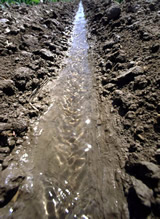This page has been archived and is being provided for reference purposes only. The page is no longer being updated, and therefore, links on the page may be invalid.
|
|
Now in Spanish: Farm-Ready Findings From Idaho Scientists
By Marcia WoodSeptember 27, 2005
Information about environmentally friendly ways to grow top-quality potatoes, sugarbeets and other crops on irrigated farmlands is available in publications from Agricultural Research Service experts in Idaho. Now the summaries, or abstracts, of more than 100 of these publications have been translated into Spanish to streamline use of these methods by Spanish-speaking farm owners, managers and workers in the United States and abroad.
The publications, written by ARS scientists specializing in soil science, agricultural engineering and plant disease at the agency's Northwest Irrigation and Soils Research Laboratory in Kimberly, Idaho, cover everything from determining the alfalfa-hay preferences of dairy cows to zapping erosion caused by irrigation water as it whooshes down furrows.
The abstracts are available online at:
http://www.nwisrl.ars.usda.gov/publist.shtml
ARS soil scientist Robert E. Sojka, who heads the Kimberly laboratory, started the "Publicaciones" project about a year ago. He did that in response to requests from growers who wanted help in communicating with their Spanish-speaking employees about how to mix a white, powdery compound called PAM (short for polyacrylamides) into irrigation water.
Sojka and colleagues at the Kimberly center pioneered the use of PAM to thwart erosion on irrigated fields. Today, PAM is combined with irrigation water on an estimated 1 million acres of U.S. farmlands and prevents erosion of millions of tons of soil every year.
University of Idaho graduate student Maria Barahona and soil scientist Ariel Szögi, with ARS in South Carolina, did the translations.
Plans call for translating several hundred more abstracts, working from the newer publications to previous ones that date back to the early 1960s.
ARS is the U.S. Department of Agriculture's chief in-house scientific research agency.


